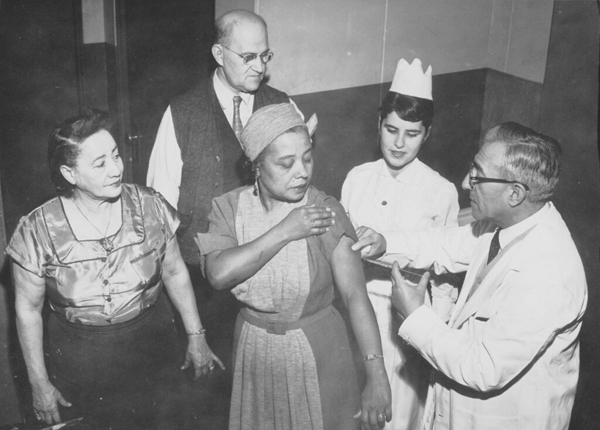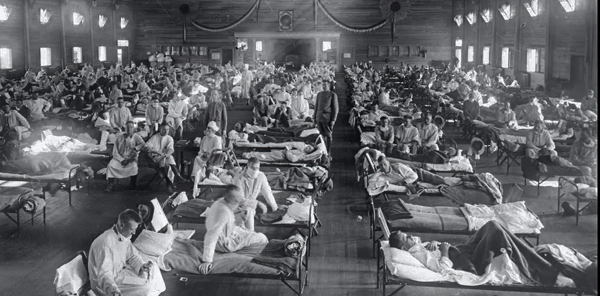The History Of Influenza Pandemics By The Numbers
When you see the World Health Organization (WHO) reporting that as of April 24, 2021, “there have been 145,216,414 confirmed cases of COVID-19, including 3,079,390 deaths, reported to WHO,” it’s easy to think that the world has never seen anything like this [1]. However, that assessment would be wrong. Covid-19 represents the fifth influenza pandemic since 1900.
Even though many people alive today are experiencing the wrath of a pandemic for the first time, those who have been around for longer will know that pandemics sweep across the world once in a while. Therefore, it's unlikely that Covid-19 will be the last pandemic we'll ever see.

(ILGWU Local 105 members receiving flu shots, includes Dr. Louie Pincuss (?), nurse Margret Shanham, Adia Petrin, Nick Petrin, and Olivia Mayaris, December 12, 1957, created by Kheel Center, Cornell University Library, no changes made, shared under the Creative Commons Attribution 2.0 Generic license)
In this article, we follow the history of major pandemics. To show the magnitude of the pandemics we cover, we support the tale of the history of influenza pandemics with numbers.
Spanish Flue: The Most Brutal Pandemic In Recent Times

If the severity of Covid-19 is to be compared to the 1918 Spanish Flu, it would need to infect about 2.5 billion people and kill about 255 million [2].
You get the numbers above when you look at the number of people infected with the Spanish Flu of 1918 as a proportion of the world’s population: 500 million infections (a third of the world’s inhabitants at the time) [2].
About 50 million deaths were recorded for the Spanish Flu [3]. Some argued that the number of deaths was as high as 100 million [4].
According to the Centers for Disease Control and Prevention (CDC), the influenza pandemic of 1918 left 675,000 people dead in the United States [2].
The CDC also reports that “Mortality was high in people younger than 5 years old, 20-40 years old, and 65 years and older”. Adding, “The high mortality in healthy people, including those in the 20-40 year age group, was a unique feature of this pandemic” [2].
Mortality denotes the number of deaths resulting from a particular disease (obtained by dividing the number of deaths by the population at a specific time and multiplying the answer by 100).
Still With Us?
One of the leading questions about the 1918 pandemic is how it finally ended. Apparently, it didn’t end. The Washington Post cites Ann Reid, the National Center for Science Education's executive director, who says, “The 1918 flu is still with us.”
But how can the 1918 virus still be with us? [5]
Teddy Amenabar, in an article published by The Washington Post, provides the answer: “The influenza virus continuously mutated, passing through humans, pigs, and other mammals. The pandemic-level virus morphed into just another seasonal flu. Descendants of the 1918 H1N1 virus make up the influenza viruses we’re fighting today” [5].
Asian Flu Of 1957

(MIS 58-15573-68, created by otisarchives4, no changes made, shared under the Creative Commons Attribution 2.0 Generic license)
According to TheLancet.com, the 1957 virus started in China before ships, trains, and airplanes spread it worldwide. The virus hit Hong Kong in April 1957, infecting around a quarter of a million people [6]. It would later spread across the world, resulting in between 1.1 million and 2 million deaths [7] [8].
By June 1957, the virus was spreading in the United States, leaving 116,000 people dead [7]. Dr. William C. Shiel Jr. writes for the medical website MedicineNet.com. He reports that “The virus came to the United States quietly, with a series of small outbreaks over the summer of 1957” [9].
Dr. Shiel adds that “When children went back to school in the fall, they spread the disease in classrooms and brought it home to their families.” This saw infection rates spiking “among school children, young adults, and pregnant women in October 1957” [9].
A paper published by The Journal of the College of General Practitioners Research Newsletter reports that “It is estimated that not less than nine million people in Great Britain had an attack of influenza during the 1957 pandemic.” The paper adds that “About 14,000 people died of the immediate effects of their attack” [10].
It looks like the Asian Flu of 1957 was stopped before it caused much damage thanks to Maurice Hilleman, who led efforts to identify the virus and amped up the production of vaccines. The website HistoryOfVaccines.org reports that “Some predicted that the U.S. death toll would have reached 1 million without the vaccine that Hilleman called for” [8].
The 1968 Influenza Pandemic
Ten years after the Asian flu of 1957, the world was on tenterhooks again because of the 1968 influenza pandemic.
This 1968 pandemic became known as the Hong Kong flu of 1968 or the Hong Kong flu pandemic of 1968. This is because the flu caused most of its earlier devastation in Hong Kong, where half a million cases were reported in the first two weeks of the pandemic [11].
According to the general-knowledge English-language encyclopedia, Britannica.com, “The 1968 flu pandemic resulted in an estimated one million to four million deaths” [11].
In the United States, the number of people who died from the 1968 influenza pandemic is estimated to be 100,000 [12].
Even though a vaccine became available toward the end of 1968, there were questions about its effects. With the virus under control in January 1969, the production of vaccines stopped [12].
The 2009 H1N1 Swine Flu
[13] According to the CDC, the 2009 H1N1 pandemic “was detected first in the United States and spread quickly across the United States and the world.”
Reports indicated that between April 2009 (when the virus emerged) and November of the same year, 50 million Americans had been infected, representing 15% of the population [14].
The CDC estimated that the H1N1 Swine flu resulted in the deaths of between 151,700 and 575,400 people across the world [13]. In America, estimates show that around 200,000 people had to be hospitalized because of the flu, with around 10,000 losing their lives [14].
The CDC also reports that the majority of deaths were among people below the age of 65. “This differs greatly from typical seasonal influenza epidemics, during which about 70 percent to 90 percent of deaths are estimated to occur in people 65 years and older,” says the CDC [13].
Covid-19: The Latest Pandemic
The World Health Organization (WHO) reports that “On December 31, 2019, WHO was informed of cases of pneumonia of unknown cause in Wuhan City, China. A novel coronavirus was identified as the cause by Chinese authorities on January 7, 2020, and was temporarily named ‘2019-nCoV.’” This was the beginning of the latest pandemic that would be subsequently known as Covid-19 [15].
According to the WHO, Covid-19 belongs to a family of viruses known as coronaviruses (CoV). When a new strain of coronaviruses is identified, it is called a novel coronavirus [15]. Covid-19 is a novel coronavirus.
With rising numbers of the infected and the virus spreading across 114 countries, on March 11, 2020, the WHO indicated that the outbreak had become a pandemic [15]. However, this was only the beginning because the numbers would rise exponentially in the following months.
As Covid-19 spread across the world, more people became infected, forcing countries to impose lockdowns, slowing economies, and sending millions out of work. By April 26, 2021, the WHO reported that “there have been 146,689,258 confirmed cases of COVID-19, including 3,102,410 deaths, reported to WHO” [1].
The Economic Meltdown
With businesses forced to close down and public transport grinding to an instant halt, the world economy also started slowing down. A BBC report cites the International Monetary Fund (IMF), which indicated that “In the United States, the proportion of people out of work hit a yearly total of 8.9% ... signaling an end to a decade of jobs expansion” [16].
Talking about the economic impact of the coronavirus pandemic, the same BBC report refers to the IMF, which estimated that “the global economy shrunk by 4.4% in 2020” Adding, “The organization [IMF] described the decline as the worst since the Great Depression of the 1930s” [16].
The Fightback
After months of intense work in the laboratories of the world’s leading pharmaceutical companies, the world breathed a sigh of relief as the British Broadcasting Corporation (BBC) reported that “A UK grandmother has become the first person in the world to be given the Pfizer Covid-19 jab as part of a mass vaccination program” [17].
Commenting about the beginning of the mass vaccination drive, British Health Secretary Matt Hancock is quoted by the BBC saying, “Today marks the start of the fightback against our common enemy, the coronavirus” [17].
An Uncertain Future

While the world reels from the effects of Covid-19, scientists warn that there are more pandemics to come unless drastic action is taken to change the way we do things.
In a dire warning, the World Economic Forum (WEF) says that “There are 1.7 million ‘undiscovered’ viruses in mammals and birds, 827,000 of which could infect humans” [18].
It’s not all bad news, however. The WEF says that “we can prevent future pandemics by better protecting Earth’s natural resources.” The same organization says that this will involve taking “steps to protect the environment and restore its natural defenses” [18].
From the suggestions of the scientists cited by the WEF, it is clear that attempting to fight viruses reactively means that viruses will always be a step ahead of humans. The scientists say, “rather than tackling pandemic outbreaks after they occur, we should be acting now to prevent them through greater conservation efforts and ending the overexploitation of Earth’s resources” [18].
References
[1] World Health Organization. WHO Coronavirus (COVID-19) Dashboard. Available at https://covid19.who.int/ (April 29, 2020).
[2] Center for Disease Control and Prevention (CDC).1918 Pandemic (H1N1 virus). Available at https://www.cdc.gov/flu/pandemic-resources/1918-pandemic-h1n1.html (March 20, 2019).
[3] Jeffrey K. Taubenberger and David M. Morens. 1918 Influenza: the Mother of All Pandemics [J]. Emerging Infectious Disease. 2006 Jan; 12(1):15-22. Available at https://www.ncbi.nlm.nih.gov/pmc/articles/PMC3291398/.
[4] Niall P.A.S. Johnson and Juergen Mueller. Updating the Accounts: Global Mortality of 1918-1920 “Spanish” Influenza Pandemic [J]. Bulletin of the History of Medicine Vol. 76, No. 1 (Spring 2002), pp. 105-115 (11 pages). Available at
https://www.jstor.org/stable/44446153?seq=1#metadata_info_tab_contents.
[5] Teddy Amenabar. The Washington Post. ‘The 1918 flu is still with us’: The deadliest pandemic ever is causing problems today. Available at https://www.washingtonpost.com/history/2020/09/01/1918-flu-pandemic-end/ (September 4, 2020).
[6] Mark Honigsbaum. The Lancet. Revisiting the 1957 and 1968 influenza pandemics. Available at https://www.thelancet.com/journals/lancet/article/PIIS0140-6736(2031201-0/fulltext#articleInformation (May 25, 2020).
[7] Center for Disease Control and Prevention (CDC). 1957-1958 Pandemic (H2N2 virus). Available at https://www.cdc.gov/flu/pandemic-resources/1957-1958-pandemic.html (January 2, 2019).
[8] The History of Vaccines. An Education resource by the College of Physicians of Philadelphia. Available at https://www.historyofvaccines.org/content/asian-influenza-pandemic.
[9] William C. Shiel Jr., MD, FACP, FACR. MedicineNet. Medical Definition of Asian Flu. Available at https://www.medicinenet.com/asian_flu/definition.htm (January 25, 2017).
[10] Epidemic Observation Unit [J]. J Coll Gen Pract Res Newsl. 1958 Aug; 1(3): 254–261. Available at https://www.ncbi.nlm.nih.gov/pmc/articles/PMC1890114/?page=4.
[11] Kara Rogers. Britannica. 1968 flu pandemic. Available at https://www.britannica.com/event/1968-flu-pandemic.
[12] Barbara J. Jester, et al. Fifty Years of Influenza A(H3N2) Following the Pandemic of 1968 [J]. Am J Public Health. 2020 May; 110(5): 669–676. Available at https://www.ncbi.nlm.nih.gov/pmc/articles/PMC7144439/.
[13] Center for Disease Control and Prevention (CDC). 2009 H1N1 Pandemic(H1N1pdm09 virus). Available at https://www.cdc.gov/flu/pandemic-resources/2009-h1n1-pandemic.html (June 11, 2019).
[14] Thomas H. Maugh II. Los Angeles Times. Swine flu has hit about 1 in 6 Americans, CDC says. Available at https://www.latimes.com/archives/la-xpm-2009-dec-11-la-sci-swine-flu11-2009dec11-story.html (December 11, 2009).
[15] World Health Organization Europe. Health topics. Coronavirus disease (COVID-19 pandemic). Available at https://www.euro.who.int/en/health-topics/health-emergencies/coronavirus-covid-19/novel-coronavirus-2019-ncov.
[16] Lora Jones, et al. BBC News. Coronavirus: How the pandemic has changed the world economy. Available at https://www.bbc.com/news/business-51706225 (January 24, 2021).
[17] BBC News. Covid-19 vaccine: First person receives Pfizer jab in UK. Available at https://www.bbc.com/news/uk-55227325 (December 8, 2020).
[18] Douglas Broom. World Economic Forum. This is how we prevent future pandemics, say 22 leading scientists. Available at https://www.weforum.org/agenda/2020/11/covid-19-pandemics-nature-scientists/ (November 27, 2020).
Cite this article
CUSABIO team. The History Of Influenza Pandemics By The Numbers. https://www.cusabio.com/c-21023.html







Comments
Leave a Comment